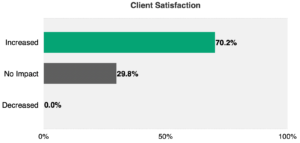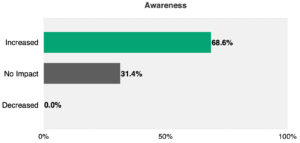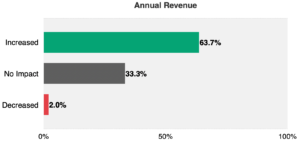The need is clear. Professional services and other knowledge driven firms must be visible where their target clients are looking for insight and help. More and more clients are choosing the ease of digital communications. In many ways the discussion has become not whether to go digital, but rather how to do it successfully. That’s what we will explore in this post.
We’ll draw upon two sources of insight. The first source is recent studies by the Hinge Research Institute examining digital transformation in the professional services, changes in buyer behavior, and the practices of the fastest growing and most profitable firms.
The second source of insight is Hinge’s experience with our own digital marketing transformations (we have had several) as well as our Hinge Marketing business unit’s work assisting dozens of professional services firms make their own transformations.
By drawing on both sources, original research, and practical implementation experience, we hope to demystify the digital marketing transformation process and help more firms experience the benefits. Let’s start by defining the core concepts.
Digital Transformation Defined
Digital transformation is the reimagining of business processes, products, and client experiences for the digital age by applying advanced digital technologies and design thinking.
The business goal is typically to provide improved client value, a better client experience, and/or operational efficiencies that result in a sustainable competitive advantage and improved financial performance. Digital transformation thinking can be applied to multiple areas of a business and often crosses traditional functional lines.
Digital Marketing Transformation Defined
Digital marketing transformation is the reimagination of the marketing and business development functions for the digital age by applying design thinking and advanced digital technologies to the entire client journey. Think of it as a particular type of digital transformation, with its own priorities and challenges.
While many digital marketing transformation projects are aimed at improving the effectiveness and efficiency of new client acquisition by responding to changes in client buying behavior, others are aimed at developing new product and services offerings, new pricing models, or improvements in the client experience.
Digital Transformation Examples
Example 1: Substituting digital for traditional techniques. This is perhaps the simplest type of digital transformation to make and a great starting place for many firms. Almost every traditional technique had a digital counterpart.

Figure 1. Online vs. offline techniques.
Figure 1 shows several examples of widely used traditional techniques such as networking or public speaking and their digital counterparts. Instead of face-to-face networking, shift to networking on social media. Likewise substitute webinars for traditional public speaking. These types of shifts, or additions of digital techniques to your marketing strategy, are easy to understand and have obvious benefits such as broader reach and lower costs.
But make sure you have the right talent to get off to a good start. If you don’t have the talent onboard, retain it from outside. Research shows this strategy improves outcomes.
Example 2: Developing digital products. Another example of a digital transformation is to develop digital products or product and service combinations. A consulting firms that specialized in helping their clients develop innovative new products had long delivered their services via on-site workshops. They transformed their face-to-face workshops into a combination on live digital workshops and pre-recorded learning modules. The net effect was dramatically lowered costs and a higher capacity with existing staff given the elimination of time intensive travel.
Another variation on this theme is to develop new digital products where there was no pre-existing traditional service. For example, when Hinge recognized the need for ongoing client education in professional services marketing, we developed Hinge University as a digital product from the start.
Example 3: Developing a digital pipeline. Perhaps nothing exemplifies a digital marketing transformation more than the development of an all-digital new business pipeline. In a digital pipeline, leads are generated and nurtured, opportunities are identified and qualified, and new clients closed, all using digital techniques.
This is the path that Hinge has followed, and the impacts have been transformative. We now receive over 85% of our leads through inbound techniques, more than half of which are fully qualified. These leads are choosing to reach out to us based on our digital thought leadership campaign. Because they are responding to our thinking, either generally or around a specific topic, they are already “self-qualifying”. Since our thought leadership reflects who we are, they are easy to close.
Our digital funnel is driven by a robust search engine optimization (SEO) strategy supported by social media and digital PR. Research both informs our marketing decisions and serves as premium content. This allows us to develop content that both speaks to targeted client needs and is highly credible. Research is the most credible and trusted form of content.
The process is supported by digital technology such as CRM and marketing automation and is largely automated. Importantly, the strategy was developed specifically for our professional services target audiences and bears little resemblance to a B2C pipeline.
With these examples in mind, lets turn our attention to the most common goals of a digital transformation. Why do firms attempt a digital marketing transformation in the first place?
Goals of Digital Transformation
The most common goals of digital transformation efforts in professional services firms fall into four broad categories:
- Improve the client experience
- Improve the efficiency of business operations
- Automate or streamline business processes
- Increase revenue and/or profitability
Given these important goals, the obvious next question is whether they were achieved?
Benefits of Digital Transformation
Importantly, the benefits of a digital transformation closely track with the most common goals.
Client satisfaction increased in about 70% of transformations

Operational efficiency improved in over 76% of firms

Awareness, a key marketing performance indicator, improved in 69% of digital marketing transformations

Increases in top line revenue were noted in 64% of cases

Bottom line profits increased in about 61% of transitions.

These numbers are even more impressive when you put them in proper context. These results include all firms completing a digital transformation, not just the “successful” ones. Given this fact, it is reassuring that decreases in performance were virtually nonexistent. It is also important to note that, on average, firms enjoyed over three of these important benefits. Taken together, these results make a strong case for a digital transformation. And making the case is often the first step in a successful transformation.
Barriers to Digital Transformation and How to Overcome Them
As appealing as the benefits of digital transformation are, only about 12% of professional services firms in our sample have completed their own transformation. This suggests that there are also some significant barriers to accomplishing the transformation.
Lack of knowledgeable, experienced staff is the most frequently cited barrier to a digital transformation. This is a very common issue, cited by nearly half of firms (45%). Many people report that staff with the appropriate skills are difficult to find and retain. Those firms that do have staff with the required skills face another hurdle.
Not enough time or bandwidth is the biggest issue for those who do have access to at least some of the required talent. Cited by about 40% of firms, this recognizes that people with relevant skill sets are in high demand and are often fully utilized on billable client work. Taken together, the relative lack of relevant digital skills and bandwidth pressure, may explain why over 70% of professional services firms have a low level of digital maturity
Both barriers have a common solution. Retain an outside firm with the missing or unavailable skills to guide you through the process. Firms that use outside resources are 8X more likely to have a successful transformation than those that rely on internal resources only.
But be cautious. Make sure the firm you select understands your industry and the type of transformation you are seeking. The ability to get it right the first time is the most important selection criteria by those who have experience with a digital transformation.
Lack of funds is another common barrier, cited by about 40% of firms. While this is a very real concern it is unfortunate given that a digital marketing transformation can be expected to increase revenue and profitability. There are approaches to your transformation that can help mitigate this issue.
One common approach is to conduct the project in phases, so that the cost is spread out over time. One might first develop the strategy and then implement it in small manageable steps.
A variation on this solution is to identify a small project that can either generate more revenue directly or save significant reoccurring expenses. This additional revenue can then be used to fund additional phases of your transformation.
Lack of support from leadership is the final major barrier, impacting about 25% of firms. If the leadership of your firm believes that there is no need for a digital marketing transformation it is difficult to make progress.
While the global pandemic has caused many management teams to see the absolute importance of a digitally driven marketing and BD strategy, there is also a need to integrate digital with face-to-face interactions in many professional services industries.
The primary solution to this dilemma is through education on the need for and payoff from a digital marketing transformation. The case, as we saw above, is compelling. Another variation on this approach is to first start with a small pilot project to demonstrate both the process and the payoffs. Small successes breed larger support. Finally, make sure you bring on a firm that understands your industry and digital marketing transformations. This will help those who see value in an integrated approach.
This brings us to the important topic of how a digital marketing transformation relates to your overall marketing strategy.
Digital Transformation and Your Marketing Strategy
Since a digital marketing transformation involves a reimagining of your entire marketing and business development process it clearly must consider other non-digital aspects of your marketing strategy. For example, your industry niche may have a must attend conference where new contacts are made, and deals are hatched. To ignore it makes no sense.
This is where many professional service firms stumble. They retain a digital transition partner who knows the technology but fails to appreciate the marketplace. The unfortunate result is either a digital marketing plan that is based on faulty assumptions, and therefore doomed to fail, or a digital island that is disconnected from other marketing or business development activities.
In our work on digital marketing transformations we encounter, sophisticated, well-funded firms that have the latest tech stack in place but are enjoying few of the benefits. Why isn’t it working? Scratch the surface and you will often find a process driven by technology rather than by client behavior or needs. Often the organization treats marketing channels as though they were unconnected from each other.
The solution to this dilemma is to look at marketing and business development as part of an overall strategic process. A digital marketing transformation can clearly update that process to enhance the client experience and impact efficiency. But it is important to remember that it should not be viewed in isolation.
So how do you conduct a digital marketing transformation in the proper strategic context? Consider using our ten-step framework.
Your Digital Marketing Transformation Framework
Hinge’s digital marketing transformation framework is designed to integrate digital and traditional marketing efforts within a strategic context. The ten steps are generally in sequential order, although they often overlap.
- Start with the business context. Start with the strategic business rationale for this transformation. What are you attempting to accomplish? Improve the client experience? Accelerate new business wins? Introduce a new digital product/service combo? This context will not only help you generate support for the initiative, but it will also help establish meaningful KPIs.
- Generate stakeholder buy in. Having broad buy-in on project goals and priorities from the start is a real benefit and makes the rest of the process easier. Sometimes the target is the senior management, other times it’s the implementors. In either case education is often the key. When others understand the business reason behind the transformation and the prospects for success, you are off to a good start. The additional firm specific insights you gain in step 4 will also be very helpful in gaining support.
- Select your transition team. At minimum your internal team should be able to have access to relevant internal resources and be able to manage the internal side of the work. If you have other internal resources who will help in implementation, make sure they have sufficient bandwidth to support the effort. Your external partner should bring both the needed technical skills as well as an appreciation for the specifics of your market. Professional services are not bought or sold like consumer products.
- Research the target audiences. This is perhaps the most important and most frequently overlooked step in the process. Assumptions about client needs, preferences, and specific buying behaviors are almost always wrong, sometimes painfully so. Insights gained here not only help you design the specifics of your transformation, but they also help you identify any gaps in your team’s understanding of your prospects and clients. This research also helps you balance your digital transformation with the more traditional strategic considerations.
- Assess where you are starting. What is already working? Where are the best opportunities for synergy between your legacy approaches and your emerging digital transformation? At Hinge, we benchmark your marketing against high-growth, high-profit firms to see what existing elements can be retained or enhanced and what new elements may be required. In the end you want an integrated strategy that ties all your marketing and business development together. Don’t build digital islands.
- Develop your digital marketing strategy. Your digital marketing strategy should be an integral part of your overall marketing strategy. You will need to understand strategic elements such as differentiators and positioning as well as more tactical considerations such as channels, content topics and type, keywords, and scheduling of activities. You will also want to specify roles and responsibilities for all key players and, of course, the KPI’s that you will want to track. This document will serve as your blueprint for the transformation.
- Develop your digital marketing tools and infrastructure. The next step is selecting and putting the needed tools and infrastructure in place. Yes, some folks get excited and start selecting and installing the new tech stack before they have a strategy in place. This is almost always a bad idea and is perhaps the biggest single cause of failure. Technology without strategy is a solution in search of a problem.
- Put tracking in place. If you can do it, having at least some tracking in place before you launch the digital transformation, is very helpful to establish a “before” baseline that you can measure against. This is doubly important if your initial project is a pilot test or demonstration project. A good baseline makes for a convincing result. Of course, sometimes no real tracking is possible without the digital infrastructure in place. It’s hard to measure a pipeline if you have no CRM system.
- Train your talent. If you have any experience with a digital marketing pipeline you understand no system will work if it is not used. It’s seldom easy to get humans to change their routines so give this step the attention it deserves. Train users on both how to use the new infrastructure and tools, but also why you should use them. Tie the reasons back to your research findings and your marketing strategy. Recognize and reward those that are doing it well and don’t give up until you have the level of compliance you need to drive success. This is where extra effort really pays off.
- Test and refine. When you have your new digital marketing system in place it may feel like the finish line. In reality, it is just the starting line for ongoing rounds of testing and refinement. You will use your ongoing tracking to review performance and adjust. Review your system’s performance each month and consider possible adjustments to test. This is where your outside partner can often add value by offering an objective opinion and suggesting options to test.
While these ten steps provide a solid framework for a digital marketing transformation, there is also some art involved in implementing any complex digital marketing pipeline. Let’s consider some tips to help make your transition smoother and more successful.
Digital Transformation Tips
We have assembled a series of practical tips to drive a successful transformation.
- Conduct or leverage research. Go into digital transformation with your eyes wide open, learning as much as you can about current systems, processes, technologies, and approaches. But don’t stop with the technology. Use existing research or commission your own research to get answers to your questions about target audience needs and buying behavior. A research-based understanding of your audience will reduce the likelihood of developing a solution that doesn’t work.
- Identify and prioritize the ways that digital transformation will advance your business. This is where studying the research will pay off. Will the digital transformation help with operational efficiency? Client satisfaction? Revenue? How much? When? This is a great way to avoid unrealistic expectations and to help determine what you will track going forward.
- Establish a long-term vision and strategy. This is where many companies drop the ball. They focus on the short term and are often blind to larger market conditions and do not see competitor impact. Focus on the longer-term trends and how your marketing strategy will take advantage of those to offer greater client value. Then document your vision.
- Involve key stakeholders in vision, strategies, and priorities. Business unit or department leaders, technology leads, and others will be helpful in being able to map people to technology, processes, and more. Consider which stakeholders will ultimately be critical to making your transformation successful and get them involved early. If they are involved in shaping the solution, they will likely be more likely to adopt it.
- Get senior management involved from the beginning. Whether the initial impetus for the digital marketing transformation came from top management or not it is important to keep them up to date as the project evolves. Make sure that they are aware of key findings from the research, the vision and strategy, the budget, and any metrics.
- Identify one or two internal champions. While this project will be collaborative and require the participation of many departments, there should be one or two leaders driving it forward. You don’t want this project to get bogged down in bureaucracy or politics so pick project leadership who has a history of getting projects to the finish line.
- If your company has never done a digital transformation project, seriously consider finding an outside partner to help. Just like climbing Mt. Everest for the first time, it makes sense to rely on a seasoned guide who can steer you around the pitfalls and ever-changing conditions involved in a digital transformation journey. Plus, the research shows that having an external partner greatly increases the likelihood of a successful outcome. Make sure they understand your industry.
- Start slowly with core processes, implement your project in phases. Take the time and attention to start with a success. Make sure it is done right and will last. Don’t take on more than you can handle – especially in the beginning. A solid success sets the stage for more ambitious phases and builds organizational support. Importantly, make sure you understand how all these phases will work together to achieve your business goals.
- Invest in a governance model. Have a document that showcases the processes, roles, tasks, and metrics that everyone can use to consistently deliver the vision and strategy. This is often overlooked and almost always regretted if it doesn’t happen.
- Remember people first, technology second. Too many companies fail with digital transformation because they focus on the technology… the shiny object. You need to make sure that you have a framework of digital skills that can be leveraged and shared. The technology is no good if there are not people who know how to leverage it and integrate it with other technology or if there is no strategic vision for how it all works together.
- Have a plan to fill digital skills and knowledge gaps. Most firms don’t start with a full team in place. Not to worry. You can fill in the gaps, but you do need a plan. This plan can include internal training, talent acquisition, or use of vendors or consultants and will help minimize typical performance disruptions.
- Track to measure and validate performance. You will want to track and measure performance so that you will be in a better position to eventually optimize it. In the beginning, your Key Performance Indicators (KPIs) may be simple, but over time they will become more sophisticated and meaningful. Start with the business goals you are trying to achieve and try to have at least one KPI for each important goal.
- Test and then test again. Before your system goes into production, invest some extra time to test the system as much as possible. When possible, use employees, clients, and family members to test out scenarios. Use people who were not involved in the development of the project as well as those that are familiar with it. You never know what may be discovered before you go live.
- When possible, incorporate data and Artificial Intelligence (AI) into your processes. In the old days, systems, applications, and technology were upgraded when the time was right. Today, AI is changing the game by continually learning and leveraging data to generate more effectiveness and efficiency. With each passing month the technology improves. Use the latest, especially if it involves self-optimization.
A Final Thought
Firms that make a digital marketing transformation are responding to changing client needs and buying patterns. That’s a smart thing to do and they are clearly enjoying the benefits of a better client experience, greater growth, and higher profitability. You can too.
But it’s not just a matter of purchasing the latest technology. Bells and whistles count for little unless they speak to real client needs and are driven by a sound marketing strategy. Never lose sight of the reasons behind your digital marketing transformation.
Additional Resources
Today, digital marketing transformation is more important than ever. But where do you start? What can you expect from your investment? And which skills do you need to develop and execute a plan? In The Professional Services Guide to Digital Marketing Transformation, we answer all these questions and more—providing the research-based advice you need to embark on your digital marketing transformation with confidence.

